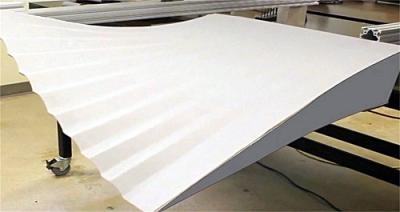Mon, Mar 03, 2014
Experimental Flaps Tested On NASA's Gulfstream G-III
A milestone for the Adaptive Compliant Trailing Edge (ACTE) project at NASA's Dryden Flight Research Center occurred in mid-February with the delivery of two revolutionary experimental flaps designed and built by FlexSys of Ann Arbor, MI, for installation on Dryden’s Gulfstream G-III Aerodynamics Research Test Bed aircraft.

Researchers are preparing to replace the airplane’s conventional 19-foot-long aluminum flaps with advanced, shape-changing assemblies that form continuous bendable surfaces. The new flexible flaps arrived at Dryden by truck on Feb. 12 and were immediately unpacked in preparation for ground vibration testing in NASA Dryden's Flight Loads Laboratory, followed by fit checks and eventual installation.
Technicians have begun scanning the G-III with a special laser system to create a computer-generated 3-D model of the airplane. The flap assemblies will also be scanned so that project engineers can conduct virtual fit checks before actually installing the new flaps. This will reduce the risk of damaging either the airplane or its new control surfaces.
The ACTE experimental flight research project is a joint effort between NASA and the U.S. Air Force Research Laboratory to advance compliant structure technology for use in aircraft to significantly reduce drag, wing weight, and aircraft noise. The effort is part of NASA's Environmentally Responsible Aviation (ERA) project that explores and documents the feasibility, benefits and technical risk of vehicle concepts and enabling technologies to reduce aviation’s impact on the environment.
(Top image: A flexible fluted structure that bridges the gap between the wing root and the shape-changing wing flap that will undergo flight tests on NASA's G-III Aerodynamic Research Test Bed is shown during preliminary tests at FlexSys, Inc. (FlexSys Photo), Bottom NASA aircraft technicians Leo and Juan Salazar work on installation of test instrumentation in preparation for installation of the experimental Adaptive Compliant Trailing Edge flap on NASA's modified G-III Aerodynamic Research Test Bed aircraft.)

More News
How To Get A Story On Aero-TV News/Feature Programming How do I submit a story idea or lead to Aero-TV? If you would like to submit a story idea or lead, please contact Jim Campbel>[...]
Aero Linx: International Association of Professional Gyroplane Training (IAPGT) We are an Association of people who fly, build or regulate Gyroplanes, who have a dream of a single >[...]
NORDO (No Radio) Aircraft that cannot or do not communicate by radio when radio communication is required are referred to as “NORDO.”>[...]
Beyond Visual Line Of Sight (BVLOS) The operation of a UAS beyond the visual capability of the flight crew members (i.e., remote pilot in command [RPIC], the person manipulating th>[...]
Aero Linx: Malibu M-Class Owners and Pilots Association (MMOPA) The Piper M-Class Owners & Pilots Association (PMOPA) is a not-for-profit organization dedicated to the interest>[...]
 ANN FAQ: Contributing To Aero-TV
ANN FAQ: Contributing To Aero-TV ANN's Daily Aero-Linx (05.29.24)
ANN's Daily Aero-Linx (05.29.24) ANN's Daily Aero-Term (05.29.24): NORDO (No Radio)
ANN's Daily Aero-Term (05.29.24): NORDO (No Radio) ANN's Daily Aero-Term (05.30.24): Beyond Visual Line Of Sight (BVLOS)
ANN's Daily Aero-Term (05.30.24): Beyond Visual Line Of Sight (BVLOS) ANN's Daily Aero-Linx (05.30.24)
ANN's Daily Aero-Linx (05.30.24)




